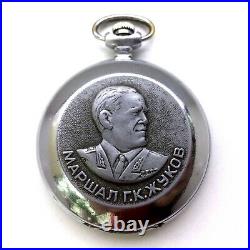
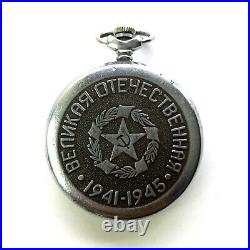
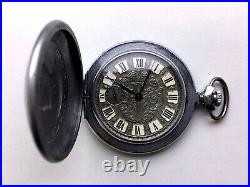
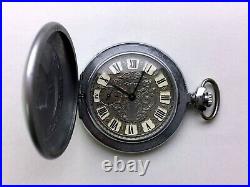
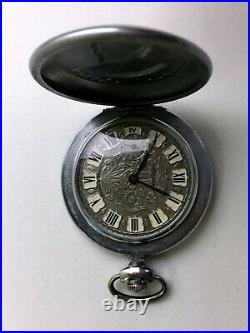
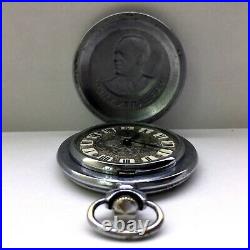
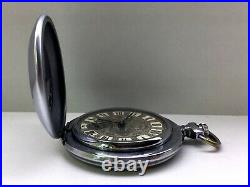
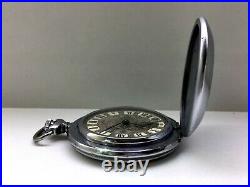





Very old Pocket Watch. Marshal Zhukov World War II. Of the Soviet Union. After the revolution in 1927, Soviet officials decided to revive domestic watchmaking, and the equipment for this purpose was looked after in the United States. Negotiations on deliveries have begun. American machines arrived in Russia in April 1930, and in September of the same year their installation was completed in the shops of the newly established First Moscow watch factory. The factory building was built in a few months on the site of a tobacco-cartridge factory on Vorontsovskaya street of the capital. The first clock in the USSR was born in those walls. First models had only four pocket watches for the officials, the mechanism of which was decorated with 15 jewels, men’s wrist watch (7 jewels) for army officers, male (7 stones) and women’s pocket watch (15 jewels) watch for civilians. A separate line of watches intended for sale outside the Soviet Union was also created. In 1935 1940, the watches of the First Moscow watch factory were manufactured on new machines, some of which were Soviet-made. In 1941, all employees of the plant along with the equipment were evacuated to the city of Zlatoust. The Great Patriotic War Began.. The history of the watch industry of our country in wartime is inextricably linked with our troops, especially with aviation. Pilots needed watches, and the First Moscow watch factory met this need. In 1945, the factory was in full swing on the clock “Victory”, adopted in production in 1946. A number of officials liked the name very much, although many of them, according to eyewitnesses, used exclusively watches “Pavel Bure” pre-revolutionary production, which by that time were rare in the USSR. The war ended, the USSR entered the 50s. There was a place in them for a special order: the “Antarctica” watch was created for participants of the first Soviet expedition to the South pole. At the heart of the “Antarctica” was the mechanism of the “Victory” watch, covered with a special casing that protects the watch from electromagnetic radiation. The launch of The first artificial earth satellite on October 4, 1957 also did not go unnoticed the domestic Sputnik watches dedicated to this event were produced only one year, for which they are valued by collectors. Next the 60s, a time of unprecedented growth, some historians consider that period the best decade in the history of our country, no matter how it was called Russia, the Russian Empire, the USSR, or the Russian Federation. This logic is very clear. Our achievements were truly outstanding in that very decade, from 1960 to 1970. The tone was set by the Soviet Union’s tremendous success in space exploration perhaps the best thing that has ever happened to us. Russian-made watches were first in space and will always remain a part of that unforgettable triumph. On April 12, 1961, Russian man and Soviet citizen Yuri Gagarin became the first Earthman in space. During the trip, he was accompanied by the legendary “Navigator” watches, produced by the already familiar First Moscow watch factory. The navigators, however, were the first inside the spacecraft. And outside of it, directly in open space, the first watch was “Strela 3017″, worn on the wrist of Alexey Leonov. It was our compatriot, twice a Hero of the Soviet Union, who made the first spacewalk in the history of mankind, which lasted 24 minutes. This happened on March 18, 1965. Soviet masters were also able to make fine watches. In a memorable 1965 began the production of fine watches “Poljot 2200″, the thickness of the mechanism which was 1.85 mm (total thickness 4 mm), izgotavleniem at the First Moscow watch factory. The watches of the First Moscow watch factory were in high demand in 70 countries, including the USA, England, Belgium, Italy, Greece, and others. The 1970s and 80s marked the “Brezhnev stagnation”, during which the export of Soviet watches did not decrease. This was not the case in the domestic market. Really high-quality watches were not so common, they were produced mainly for the military. The Ocean watch is the best proof of this. The first model was presented in 1976, intended as a novelty for the officers of the Soviet Navy. Their quality was unquestionable, but they were not available to the General public. The watch industry of the Soviet Union, of course, could not compare with the watch production of pre-revolutionary Russia. The USSR could offer high-quality watches, which later became legendary, but they still fell short of the works of watchmaking from the time of, say, Empress Catherine. Long before the formation of the USSR, masters like Kulibin and Cox created real works of art, there was scope for creativity. Nevertheless, the most complex in design and beautiful in appearance Kulibin’s watch could afford only rich people, who were not so many. The Communist system was notoriously monotonous in everything, but almost all Soviet citizens could afford watches. Again, only Pavel Pavlovich Bure managed to combine mass production with high quality before the revolution. And we do not set ourselves the task of evaluating communism or the monarchy, but only stating the facts. Various types of government, of course, have their own advantages and disadvantages, victories and defeats. By the end of the 80’s, the workers of our watch industry, on the one hand, could be a little pleased to understand that Hong Kong and Singapore bought 3-4 million watches a year in the USSR. This product is very old and has signs of aging. In case of unforeseen circumstances, do not rush to open a dispute, write to me, and I will begin to solve the problem. If you have any complaints, questions or concerns, I will be happy to answer them. The most valuable thing for me is your opinion and satisfaction, my reputation is also very important for me. Thank you for your understanding, waiting for your feedback! The item “Military pocket watch Marshal Zhukov Soviet mechanical working watches USSR” is in sale since Thursday, January 30, 2020. This item is in the category “Jewelry & Watches\Watches, Parts & Accessories\Watches\Pocket Watches”. The seller is “sagulatus” and is located in Irpin. This item can be shipped worldwide.
- Water Resistance: Not Water Resistant
- Model: Pocket Watches
- Country/Region of Manufacture: Russian Federation
- Department: Unisex Adult
- Style: Soviet style
- Case Color: Silver
- Case Material: Stainless Steel
- Dial Style: 12-Hour Dial
- Movement: Mechanical (Hand-winding)
- Type: Pocket Watch
- Customized: No
- Vintage: Yes
- MPN: 547658756
- Dial Color: Silver
- Display: Analog
- Brand: Molnija
- Features: 12-Hour Dial
- Made in the: USSR
- Material: Metall
- Year of Manufacture: 1920-Now

